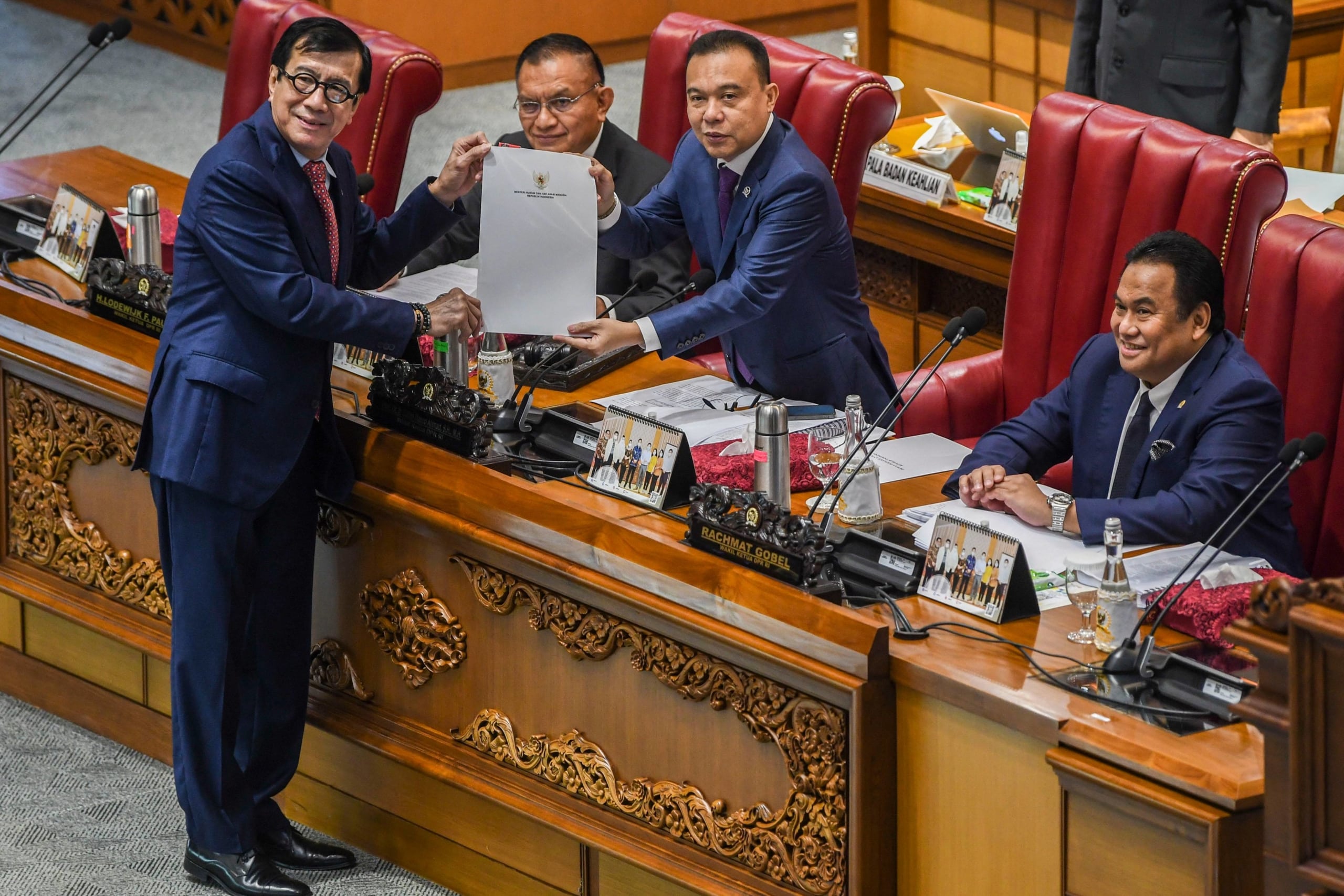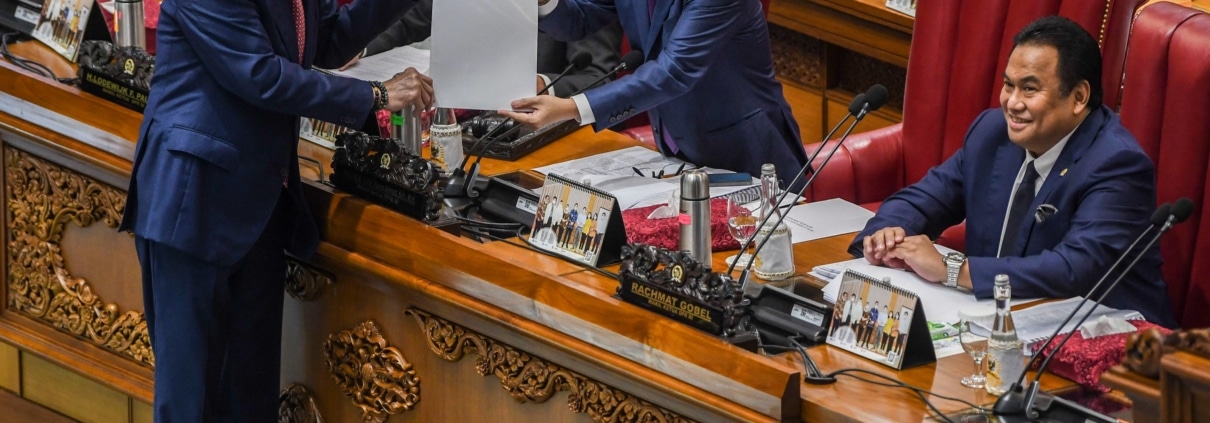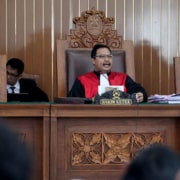
Minister of Law and Human Rights Yasonna H Laoly hands over the government position on the Criminal Code to members of the national legislature (DPR) on 6 December. Photo by Galih Pradipta for Antara.
Global media coverage of Indonesia’s new Criminal Code (KUHP) has focused on how the code deals with extramarital sex and cohabitation, and how it contributes to Indonesia’s democratic decline. The code’s provisions recognising criminal “living law” – or adat (traditional or customary law) – have drawn much less attention but are also problematic.
Article 2 is the main provision of the code dealing with living law. It must be read alongside Article 1(1), which states that “No act can attract a criminal sanction or action unless on the strength of a criminal provision in a law that existed before the act was performed” [emphasis added]. This is the fundamental principle of legality, which prohibits the retrospective application of criminal laws. The Elucidation to Article 1(1) says that “law” here means statutes or regional regulations (peraturan daerah or perda).
Article 2(1) then says that Article 1(1) does not affect the applicability of “living law” that determines whether an act should be criminal even if not prohibited in the code. Article 2(3) requires the government to issue a regulation (Peraturan Pemerintah) concerning the “procedures and criteria to stipulate living law”.
Confusingly, while the code states that it comes into force after three years, it also states that all implementing regulations, such as this government regulation, must be issued within two years of the KUHP’s enactment – that is, at least a year before the code itself comes into force. If enacted within two years, this regulation will, therefore, surely be challengeable on the grounds that the basis for its legality is not yet operational.
These living law provisions are not the first to recognise customary criminal law in Indonesia. Criminal adat already applies in limited circumstances under a 1951 Emergency Law. Successive Judicial Power Laws (most recently Law No. 48 of 2009) have also enabled judges to consider “legal values and feelings of justice living in the community” when hearing and deciding cases. This is commonly cited as a primary legal basis for the application of adat in criminal and civil legal proceedings.
In other areas of law, Indonesian lawmakers have long appealed to customary law to legitimise legal changes and, more recently, have issued laws that recognise the entitlements of customary communities to various natural resources. The primary legal basis for this recognition is Article 18B(2) of the Indonesian Constitution, which requires the state to respect customary communities and traditional rights, if they still exist, and in accordance with the development of the community and the principle of the Unitary State of the Republic of Indonesia.
The extent to which Indonesian courts have recognised and applied customary criminal law under the 1951 Emergency Law and the 2009 Judicial Power Law has not, to my knowledge, been extensively described. But it seems relatively rare.
Article 622(1)(b) of the new KUHP invalidates the 1951 provisions under which courts could apply criminal adat. But precisely what has replaced them is unclear. In particular, there is still significant uncertainty about whether criminal adat norms must first be defined in a perda for judges to apply them in trials, or judges can simply determine those norms independently.
The first interpretation – that adat criminal law cannot be applied unless a perda has defined the act prohibited by that law – is supported by the Elucidation to Article 2. However, that support is ambiguous. The Elucidation to Article 2(1) states that “To strengthen the existence of living law in the community, a perda is to regulate the criminal living law”. The ambiguity here is that these words do not clearly indicate that living law relies upon being included in a perda for its existence or validity. After all, one cannot strengthen something that does not already exist.
The Elucidation to Article 2(3) then says that the government regulation (Peraturan Pemerintah) that should be issued on living law will be “a guide for regional [governments] to stipulate living law in perda”. Again, this is ambiguous, because the Elucidation does not clearly establish that living law will only be valid if described in a perda. Indeed, use of the word “guide” (pedoman) indicates that there might be some way of recognising living law apart from the government regulation.
Adding weight to this interpretation is that local governments already have power to establish minor criminal offences by way of perda. These provisions could, therefore, just constitute directions about how local governments might regulate living law in those perda.
The second interpretation – that judges can identify and apply criminal adat even without a perda – is more convincing because it seems to be established by the provisions of the KUHP rather than their Elucidation. Articles 1(1) and 2(1) clearly operate on the assumption that living law is largely unwritten. Otherwise, Article 2(1) is superfluous. If living law was written in a statute or a perda, then it would fall within the meaning of ‘law’ in Article 1(1). It would already be established as a legal principle in no need of the validation that Article 2(1) seems designed to provide.
Supporting this interpretation is the following statement in the General Elucidation to the code: “in reality, in various regions… there are still rules of unwritten law which live and are recognised as law… which determine that violations of that law should be dealt with as criminal matters. In these circumstances, judges can impose a sanction…”.
Because these two interpretations contradict each other, we might expect Indonesian judges to find applying the code’s living law provisions difficult, if not impossible. But even if a path can be found to make either interpretation operable, either is likely to raise significant controversy.
On the one hand, if judges are able to (continue to) uncover criminal adat principles directly, then long-standing problems of proof arise. Given that most adat is unwritten, witness testimony is usually required to determine its content. This brings with it many complications and difficulties. For example, is it possible to find an objective witness from a close knit community affected by an act to testify about the supposed criminality of that act? There is significant scope for principles to be applied as living law that are not living law at all, to favour partisan interests.
On the other hand, if criminal adat needs to be in a perda before the courts can apply it, then the KUHP’s living law provisions depend on whether local governments take action to issue such perda. If past practices are anything to go by, many local governments will not take this action.
For example, provisions that grant traditional communities access to natural resources have generally required, as a precondition, local governments to formally recognise the existence of those communities, by identifying them in a perda. This is the case with the government’s social forestry program, which requires customary communities to be recognised in a perda before they can be granted forest access and management rights. However, local lawmakers have been criticised for failing to do this, or for taking an inordinate time to do so. It is often suspected or assumed that the personal financial interests of lawmakers play a role.
In this context, one can easily imagine local governments using these provisions to justify the prohibition of acts that, far from violating “living law”, might instead protect their personal interests. To take one hypothetical example, a local legislature might invent criminal adat principles that prohibit citizens from accessing a commercial plantation area in which its members have a financial interest.
Also, reducing customary law to writing deprives it of its key characteristics: fluidity and adaptability to change. These characteristics seem intended to be conveyed in the use of the term “living law” rather than “adat”. This captures the idea that community norms can shift as community life changes. Even a well-meaning local legislature may set in stone principles that do not accurately reflect the living law as practiced, or which remain on the books well after a customary community no longer observes these principles.
The KUHP, including its living law provisions, will undoubtedly be challenged at the Constitutional Court in the coming weeks or months. But whether the court will hear those challenges before the code comes into force in three years is unclear.
Unfortunately, because the Constitutional Court’s independence from government is now in serious doubt, it seems likely that, even if the court were to hear such a challenge, any decision is unlikely to remedy this or any of the many other constitutional difficulties that the KUHP raises.











